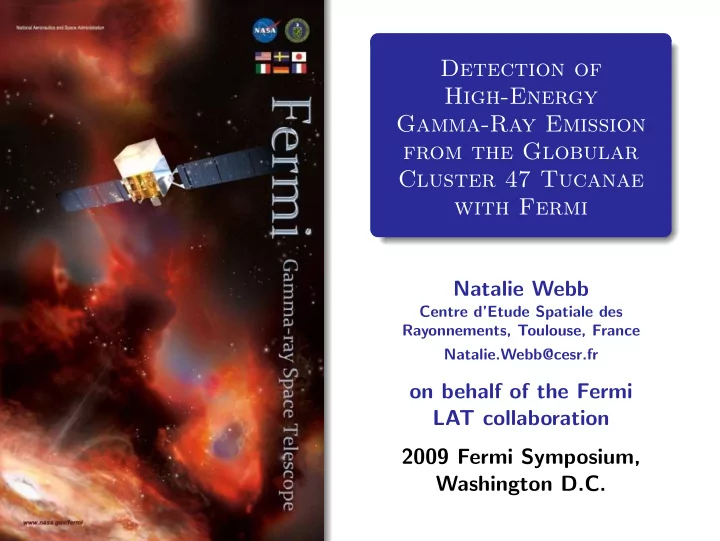

Detection of High-Energy Gamma-Ray Emission from the Globular Cluster 47 Tucanae with Fermi Natalie Webb Centre d’Etude Spatiale des Rayonnements, Toulouse, France Natalie.Webb@cesr.fr on behalf of the Fermi LAT collaboration 2009 Fermi Symposium, Washington D.C.
Galactic globular clusters ◮ Dense groups of old stars (10 5 − 6 stars) ◮ Stable on dynamical timescales ( ∼ 10 6 yr) ◮ Unstable on thermal timescales ( ∼ 10 9 yr) 47 Tuc, Anglo-Australian Observatory Red stars = radio MSPs Natalie Webb (CESR) 2009 Fermi Symposium, Washington D.C. 2 / 10
Globular cluster energy sources Compact binaries: Artist’s impression of an X-ray binary (Credits: ESA, NASA and Felix Mirabel) Artist’s impression of a pulsar (Credit: NASA) Natalie Webb (CESR) 2009 Fermi Symposium, Washington D.C. 3 / 10
High energy emission from pulsars ◮ Three models: ◮ polar cap ◮ outer gap ◮ slot gap ◮ Inverse Compton scattering/ curvature radiation → γ -rays ◮ Discovery of γ -ray emission from MSPs (Abdo et al. M ∼ 1.4 M ⊙ , R ∼ 10 km, B ∼ 10 7 − 9 G 2009a,b) Natalie Webb (CESR) 2009 Fermi Symposium, Washington D.C. 4 / 10
47 Tucanae ◮ 23 millisecond pulsars known (radio detection, Freire a ) ◮ γ -ray emission detected with the Fermi LAT (17 σ ) ◮ L (200 MeV − 10 GeV ) = (4.8 ± 1.2) × 10 34 erg s − 1 (distance = 4.0 ± 0.4 kpc) Circle: 95% confidence region for the location of the gamma-ray source. a http://www.naic.edu/ pfreire/GCpsr.html Natalie Webb (CESR) 2009 Fermi Symposium, Washington D.C. 5 / 10
Gamma-ray spectrum of 47 Tuc Fit ◮ Γ = 1.3 ± 0.3 ◮ E cut − off = 2.5 ± 1 . 6 0 . 8 GeV ◮ Typical of other Fermi MSPs Natalie Webb (CESR) 2009 Fermi Symposium, Washington D.C. 6 / 10
How many millisecond pulsars in 47 Tuc? ◮ Spin down energy ( ˙ E) ∝ I ω ˙ ω ◮ Efficiency ( η γ ) = L / ˙ E ◮ Using the average ˙ E → η γ = 0.12 ± 0.05 f Ω / N 23 ◮ Using η γ = 0.08 ± 0.02 f Ω (for the closest Fermi MSPs) implies < 60 MSPs in 47 Tuc Natalie Webb (CESR) 2009 Fermi Symposium, Washington D.C. 7 / 10
Looking for γ -ray pulsations Radio observations (Freire et al. 2003) ◮ Ongoing work ◮ No pulsations confirmed at > 5 σ ◮ Appears that the emission is not dominated by one/ a few pulsar(s) Natalie Webb (CESR) 2009 Fermi Symposium, Washington D.C. 8 / 10
...and what about other Galactic globular clusters? Natalie Webb (CESR) 2009 Fermi Symposium, Washington D.C. 9 / 10
Summary ◮ γ -ray emission detected from a globular cluster for the first time ◮ Emission appears to be consistent with a population of millisecond pulsars ◮ Estimate < 60 millisecond pulsars in 47 Tucanae ◮ Some other globular clusters are starting to be detected Natalie Webb (CESR) 2009 Fermi Symposium, Washington D.C. 10 / 10
Recommend
More recommend